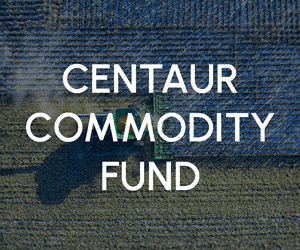Analys
The WTI bulls are coming. Curve set to flip to backwardation


A cocktail of bullish factors are hitting the supply side.
We have ongoing cuts by OPEC+.
Venezuela is deteriorating rapidly with latest news that due to a blackout its main port is now closed (accounts for about 90% of exports). The country exported 1.7 m bl/d of crude in early 2017 which declined to 1.25 m bl/d in 2018 but now rapidly seems to head to zero.

Algeria is the new runner up with crowds marching the streets while the military chief of staff is demanding that the 20 year ruling president Bouteflika should step down. US sanctions towards Iran are up for renewal in May and the US has signalled that it may be difficult to extend waivers. Algeria is today producing some 1 m bl/d.
Iran. The name of the US sanctions game is “a tightening screw”. It will likely still be possible for S. Korea and others to import oil from Iran, but the quota will most likely shrink in May. How much will depend on the oil price.
If the price is too high in the eyes of Donald Trump he may roll the current waivers forward in order to protect the US consumers (and his voters). US economic advisors have however recently stated that a higher oil price is now a positive for the US economy as it increasingly becomes an oil exporter. The negatives for the consumers are outweighed by the positives for the producers if the oil price is high. I.e. the US is becoming more like OPEC J.
US shale oil on debt dieting. The end of the shale oil boom or the slow-down of the shale oil boom has been called time and time again. There is no doubt that the boom so far has been fuelled by debt and that the industry is still largely running cash flow negative. Some macro analysts have lately stated that companies in general will start to deleverage. If that is the case then this will surely also be the case for US shale. Latest signals from the industry is Schlumberger stating this week that they expect a double digit drop in spending from its customers in North America this year (blbrg). Underlining this is Devon Energy which signals that it will cut its headcount from 2500 to only 1700. So maybe we now finally do see a slowdown in US shale oil production growth. There are however many sides to the US shale story of which one is that the industry completed the highest number of wells in February (1325) since 2015 in nominal terms and the highest ever in real terms. They still completed more than they completed.
US oil inventories. API yesterday reported indicative numbers for US oil inventories last week. Crude: +0.7 m bl, Gasoline: -3.5 m bl and Middle Distillates: -4.3 m bl/d. Over the past 8 weeks the US crude, gasoline and middle distillate stocks have declined by 34 m bl. The seasonal normal (past 5yrs) is for a rise of 23 m bl. In total it equates to a seasonally adjusted draw of 57 m bl. Today at 15:30 CET we’ll have the actual data. But all indicates that we’ll get another solid draw overall for crude and products today.
Bulls, WTI, Brent, OPEC cuts and spec. We have argued several times that cuts by OPEC+ was a two stage process. 1) Dry up the global market and the Brent crude curve. 2) US exports rise and imports decline and the US market dries up as well. This is exactly what has happened. Over the past 8 weeks exports were 27 m bl higher in comparable terms to Q4-18 while imports were 14 m bl lower in comparable terms to Q4-18.
Crude curve convergence. Bulls coming to WTI. The consequence of the above point was that bulls were first to run into the Brent crude curve. Now that the US inventories are drying up the WTI curve is increasingly firming and bulls are piling in.
Ch1: Global market and the Brent crude curve firmed first. Now the WTI crude curve is just around the corner to shift into full backwardation as well. That will fuel the bulls to run towards positive roll yields in the WTI curve. It will lift WTI. The WTI front end contango has held back gains for Brent. So backwardation also in WTI will help to free the Brent bulls
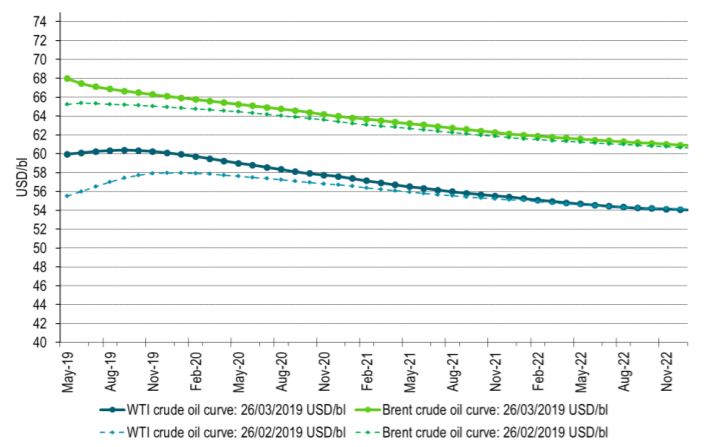
Ch2) Sharp delcline in US crude, gasoline and mid-dist inventory as imports decline and exports rise

Ch3) Brent bulls came first. Now the WTI bulls are coming
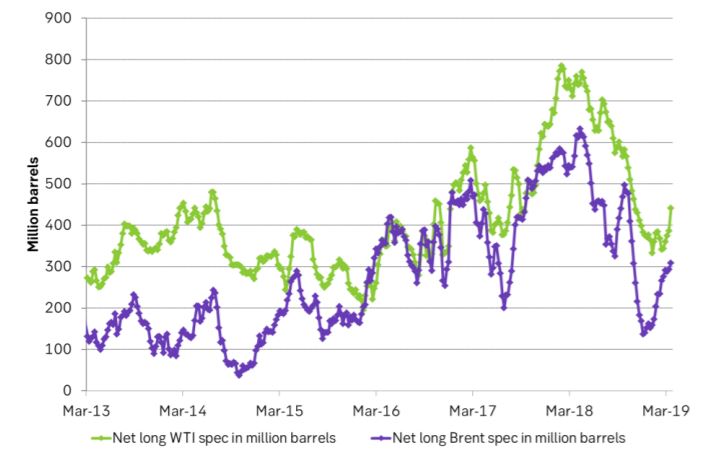
Ch4): Brent and WTI crude curve convergence. The WTI crude curve shape is rapidly shaping up to the Brent curve shape
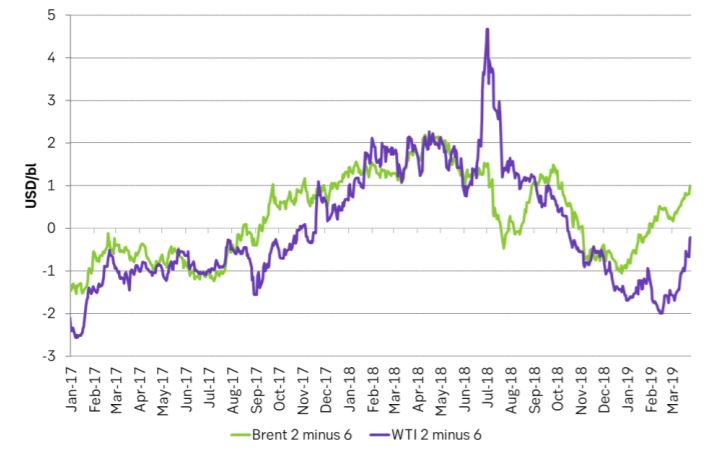
Analys
Tightening fundamentals – bullish inventories from DOE

The latest weekly report from the US DOE showed a substantial drawdown across key petroleum categories, adding more upside potential to the fundamental picture.

Commercial crude inventories (excl. SPR) fell by 5.8 million barrels, bringing total inventories down to 415.1 million barrels. Now sitting 11% below the five-year seasonal norm and placed in the lowest 2015-2022 range (see picture below).
Product inventories also tightened further last week. Gasoline inventories declined by 2.1 million barrels, with reductions seen in both finished gasoline and blending components. Current gasoline levels are about 3% below the five-year average for this time of year.
Among products, the most notable move came in diesel, where inventories dropped by almost 4.1 million barrels, deepening the deficit to around 20% below seasonal norms – continuing to underscore the persistent supply tightness in diesel markets.
The only area of inventory growth was in propane/propylene, which posted a significant 5.1-million-barrel build and now stands 9% above the five-year average.
Total commercial petroleum inventories (crude plus refined products) declined by 4.2 million barrels on the week, reinforcing the overall tightening of US crude and products.
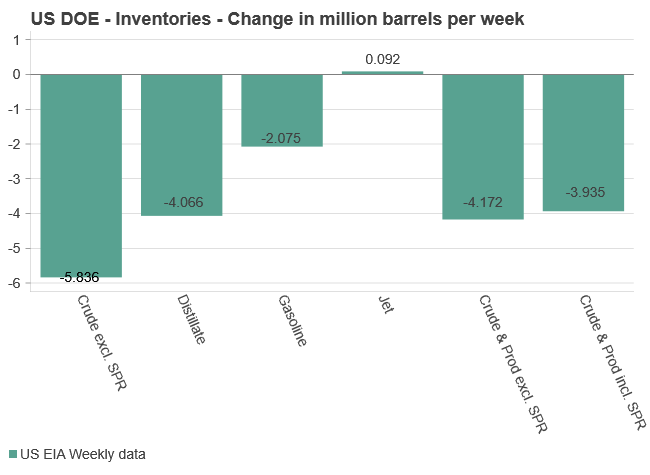

Analys
Bombs to ”ceasefire” in hours – Brent below $70

A classic case of “buy the rumor, sell the news” played out in oil markets, as Brent crude has dropped sharply – down nearly USD 10 per barrel since yesterday evening – following Iran’s retaliatory strike on a U.S. air base in Qatar. The immediate reaction was: “That was it?” The strike followed a carefully calibrated, non-escalatory playbook, avoiding direct threats to energy infrastructure or disruption of shipping through the Strait of Hormuz – thus calming worst-case fears.

After Monday morning’s sharp spike to USD 81.4 per barrel, triggered by the U.S. bombing of Iranian nuclear facilities, oil prices drifted sideways in anticipation of a potential Iranian response. That response came with advance warning and caused limited physical damage. Early this morning, both the U.S. President and Iranian state media announced a ceasefire, effectively placing a lid on the immediate conflict risk – at least for now.
As a result, Brent crude has now fallen by a total of USD 12 from Monday’s peak, currently trading around USD 69 per barrel.
Looking beyond geopolitics, the market will now shift its focus to the upcoming OPEC+ meeting in early July. Saudi Arabia’s decision to increase output earlier this year – despite falling prices – has drawn renewed attention considering recent developments. Some suggest this was a response to U.S. pressure to offset potential Iranian supply losses.
However, consensus is that the move was driven more by internal OPEC+ dynamics. After years of curbing production to support prices, Riyadh had grown frustrated with quota-busting by several members (notably Kazakhstan). With Saudi Arabia cutting up to 2 million barrels per day – roughly 2% of global supply – returns were diminishing, and the risk of losing market share was rising. The production increase is widely seen as an effort to reassert leadership and restore discipline within the group.
That said, the FT recently stated that, the Saudis remain wary of past missteps. In 2018, Riyadh ramped up output at Trump’s request ahead of Iran sanctions, only to see prices collapse when the U.S. granted broad waivers – triggering oversupply. Officials have reportedly made it clear they don’t intend to repeat that mistake.
The recent visit by President Trump to Saudi Arabia, which included agreements on AI, defense, and nuclear cooperation, suggests a broader strategic alignment. This has fueled speculation about a quiet “pump-for-politics” deal behind recent production moves.
Looking ahead, oil prices have now retraced the entire rally sparked by the June 13 Israel–Iran escalation. This retreat provides more political and policy space for both the U.S. and Saudi Arabia. Specifically, it makes it easier for Riyadh to scale back its three recent production hikes of 411,000 barrels each, potentially returning to more moderate increases of 137,000 barrels for August and September.
In short: with no major loss of Iranian supply to the market, OPEC+ – led by Saudi Arabia – no longer needs to compensate for a disruption that hasn’t materialized, especially not to please the U.S. at the cost of its own market strategy. As the Saudis themselves have signaled, they are unlikely to repeat previous mistakes.
Conclusion: With Brent now in the high USD 60s, buying oil looks fundamentally justified. The geopolitical premium has deflated, but tensions between Israel and Iran remain unresolved – and the risk of missteps and renewed escalation still lingers. In fact, even this morning, reports have emerged of renewed missile fire despite the declared “truce.” The path forward may be calmer – but it is far from stable.
Analys
A muted price reaction. Market looks relaxed, but it is still on edge waiting for what Iran will do

Brent crossed the 80-line this morning but quickly fell back assigning limited probability for Iran choosing to close the Strait of Hormuz. Brent traded in a range of USD 70.56 – 79.04/b last week as the market fluctuated between ”Iran wants a deal” and ”US is about to attack Iran”. At the end of the week though, Donald Trump managed to convince markets (and probably also Iran) that he would make a decision within two weeks. I.e. no imminent attack. Previously when when he has talked about ”making a decision within two weeks” he has often ended up doing nothing in the end. The oil market relaxed as a result and the week ended at USD 77.01/b which is just USD 6/b above the year to date average of USD 71/b.

Brent jumped to USD 81.4/b this morning, the highest since mid-January, but then quickly fell back to a current price of USD 78.2/b which is only up 1.5% versus the close on Friday. As such the market is pricing a fairly low probability that Iran will actually close the Strait of Hormuz. Probably because it will hurt Iranian oil exports as well as the global oil market.
It was however all smoke and mirrors. Deception. The US attacked Iran on Saturday. The attack involved 125 warplanes, submarines and surface warships and 14 bunker buster bombs were dropped on Iranian nuclear sites including Fordow, Natanz and Isfahan. In response the Iranian Parliament voted in support of closing the Strait of Hormuz where some 17 mb of crude and products is transported to the global market every day plus significant volumes of LNG. This is however merely an advise to the Supreme leader Ayatollah Ali Khamenei and the Supreme National Security Council which sits with the final and actual decision.
No supply of oil is lost yet. It is about the risk of Iran closing the Strait of Hormuz or not. So far not a single drop of oil supply has been lost to the global market. The price at the moment is all about the assessed risk of loss of supply. Will Iran choose to choke of the Strait of Hormuz or not? That is the big question. It would be painful for US consumers, for Donald Trump’s voter base, for the global economy but also for Iran and its population which relies on oil exports and income from selling oil out of that Strait as well. As such it is not a no-brainer choice for Iran to close the Strait for oil exports. And looking at the il price this morning it is clear that the oil market doesn’t assign a very high probability of it happening. It is however probably well within the capability of Iran to close the Strait off with rockets, mines, air-drones and possibly sea-drones. Just look at how Ukraine has been able to control and damage the Russian Black Sea fleet.
What to do about the highly enriched uranium which has gone missing? While the US and Israel can celebrate their destruction of Iranian nuclear facilities they are also scratching their heads over what to do with the lost Iranian nuclear material. Iran had 408 kg of highly enriched uranium (IAEA). Almost weapons grade. Enough for some 10 nuclear warheads. It seems to have been transported out of Fordow before the attack this weekend.
The market is still on edge. USD 80-something/b seems sensible while we wait. The oil market reaction to this weekend’s events is very muted so far. The market is still on edge awaiting what Iran will do. Because Iran will do something. But what and when? An oil price of 80-something seems like a sensible level until something do happen.
-

 Nyheter3 veckor sedan
Nyheter3 veckor sedanStor uppsida i Lappland Guldprospekterings aktie enligt analys
-

 Nyheter4 veckor sedan
Nyheter4 veckor sedanBrookfield ska bygga ett AI-datacenter på hela 750 MW i Strängnäs
-

 Nyheter4 veckor sedan
Nyheter4 veckor sedanSommaren inleds med sol och varierande elpriser
-

 Nyheter4 veckor sedan
Nyheter4 veckor sedanOPEC+ ökar oljeproduktionen trots fallande priser
-

 Nyheter3 veckor sedan
Nyheter3 veckor sedanSilverpriset släpar efter guldets utveckling, har mer uppsida
-

 Analys4 veckor sedan
Analys4 veckor sedanBrent needs to fall to USD 58/b to make cheating unprofitable for Kazakhstan
-

 Nyheter4 veckor sedan
Nyheter4 veckor sedanTradingfirman XTX Markets bygger datacenter i finska Kajana för 1 miljard euro
-

 Nyheter2 veckor sedan
Nyheter2 veckor sedanUppgången i oljepriset planade ut under helgen




